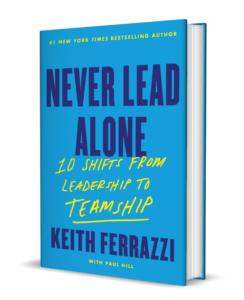As business leaders navigate a rocky reopening and the care of a workforce stressed after months of forced remote work, one word that keeps coming up in my conversations with executives is resilience. They know resilience is important and the word sounds great, but specifically, what is resilience and where do we get it? How do we identify it, and how do we enhance it?
These are all great questions to bring to Taryn Marie Stejskal, Ph.D., an international expert on the topic and someone who’s spent more than a decade focused on understanding leadership resilience and coaching top executives to be more resilient. Dr. Taryn Marie is the Chief Resilience Officer (CRO) at Resilience Leadership and her book, Flourish or Fold: The Five Practices of Particularly Resilient People, is due out next year. Dr. Taryn Marie completed pre- and post-doctoral fellowships in neuropsychology before turning to the corporate world over a decade ago.
Her specific definition of resilience? It’s the willingness to engage challenge, change, and complexity actively; to allow ourselves to be enhanced by the experience, not diminished. By focusing on action, resilient “doing” rather than just resilient thinking, she’s filling a gap in a field populated by other work such as Carol Dweck’s “growth mindset.”
Dr. Taryn Marie has a good deal to say about how individuals can gain resilience, but I was particularly interested in the question of team resilience, how to intervene in the fabric of a team to make it more resilient. That starts with a powerful question that can be asked of an individual or a team: “Think of a time when you faced a significant challenge. How did you effectively address that challenge?”
Having listened to hundreds of answers to this question, Dr. Taryn Marie has identified the Five Practices. (They apply very well to teams, too.) These are behaviors that can help any of us or the teams we’re part of to operate in more resilient ways when we face challenges instead of freezing, fighting, or running away. Let’s take a look at each of the five practices and understand how we can put them into action.
Vulnerability. This one’s a hallmark of high performing teams. Conventional thinking says that leaders and teams should project confidence and mastery. “Not so,” says Dr. Taryn Marie. “While leaders should celebrate success and growth, they should also make sure to celebrate how their team effectively addressed challenges.” That makes sense: Vulnerability is the cornerstone of a team’s ability to build the psychological safety needed to take risks, innovate, and challenge each other. Teams should make this practice real by putting time on their agendas to share both failures and challenges as well as successes with the whole team.
Productive Perseverance. A big piece of resilience is having the capacity to adjust and fluidly navigate between maintaining the mission and shifting in a new direction. To strengthen the practice of productive perseverance, a team should do two things: One, engage in agile practices, working in short weekly project “sprints,” and focusing the team relentlessly on clear goals and progress. Two, get clear on why a goal exists and question how the work aligns with the organization’s broader purpose, mission, and vision. In discussions like these, I often designate someone in the room to be the Yoda, to listen carefully to the conversation, and then have explicit permission to say what they believe no one else is articulating but needs to be said.
Connection. Teams are the most resilient when their members are connected internally as in, self-awareness and open to listening to and trusting others in the group, and externally in the sense of relying on and gaining encouragement from a wider circle of colleagues, friends, and neighbors. To make the practice of connection real, a leader ought to develop a team charter that creates alignment and focuses on how the team will drive work across the organization effectively. Leaders should also ask themselves and others, “How are you really?” and carefully listen to the answer.
Grati-osity. Dr. Taryn Marie coined this word to describe a practice that combines gratitude and generosity. The gratitude comes in when teams reflect back to see the good in the challenge, how it changed them for the better, even if they wouldn’t have chosen it. The generosity is in sharing these stories openly, rather than simply doling out advice, so that others may learn from the experience. Leaders should also spend more designated agenda time celebrating successes, regularly sharing appreciation for each other, giving recognition, and gratitude with team members. The next step after that would be to do a collaborative problem session around what team members learned or gain
ed from a recent challenge or failure.
“Rather than assuming a team member didn’t complete a task, ask if you might have missed an email or document, or ask how you can collaborate with or support him or her.”
A key component here is to remember to assume positive intent across team members. Many of us are being pushed to our edge of change with a worsening health crisis, closed summer camps forcing working parents to continue juggling childcare and office work, and seismic shifts in the social structure as Americans address racism, injustice, and inequity. By believing that your team is doing the best they can, you can communicate support, patience, and empathy. Rather than assuming a team member didn’t complete a task, ask if you might have missed an email or document, or ask how you can collaborate with or support him or her.
Possibility. Particularly resilient teams see possibilities even in the face of challenges. They’re able to experience the danger and fear of failure but not be detoured by it. They focus on progress, not perfection. To harness the power of possibility, teams should challenge themselves to stretch into new areas in order to address the opportunities and possibilities being presented by the market. Great teams I’ve worked with make this happen through a process called “bullet-proofing.” After colleagues share their plans or reports in a group meeting, have the team break into small groups and “bulletproof” each other’s work by offering one risk that the individual might guard against, one innovative idea the individual might consider, and one act of generosity that the group could offer by way of help.
Dr. Taryn Marie got to see firsthand how Kraft Heinz, one of the largest food distributors in the world, demonstrated many of The Practices of Particularly Resilient People in the jaws of the pandemic. When Mitch Arends, its head of U.S. manufacturing, reflected on Kraft Heinz’s reaction to the COVID-19 pandemic, two themes came to mind. First, Arends felt that the ability to be agile was critical to responding to market conditions, seemingly overnight. Decisions that previously may have taken weeks or months were trimmed to days or even hours. For example, early in the panic-buying stage, Kraft Heinz realized it wouldn’t be possible simply to produce more without changing what products they produced. So, they narrowed the foods they made to those that were in the highest demand such as Mac & Cheese, and worked with grocery store partners to ship them full pallets of the same products instead of mixed pallets. These actions simplified the process of making, shipping, and stocking these products, which allowed Kraft Heinz to meet the demand surge.
The disruption led to much more closely connected relationships among employees. Employees at Kraft Heinz have always owned their own tasks and responsibilities, but two-way communication is now faster and more effective, which allows innovations to bubble up from everywhere. For example, employee suggestions crucially informed the way workers socially distance within plants and led to a system for tracking where COVID-19 is circulating within its communities. This has been the reason Kraft Heinz has been able to keep producing at such a high level. Arends says that Kraft Heinz plans to make many of these innovations permanent, using the lessons to continue simplifying the manufacturing process.
It’s time to recognize that resilience is a team sport. Teams fail or succeed together, and we collectively enhance or detract from one another’s resilience. We need to avoid directly competing with others on our teams, and instead support and encourage one another. Focus on this aspect of resilience by believing you and your team members are collectively responsible for the team’s deliverables, not simply the work assigned to your immediate group or direct reports. By working together, teams can achieve greater successes, be more agile, and deliver products and services that are connected to the current needs of the market.






